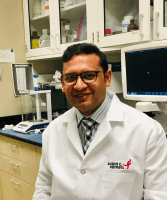Chemotherapy and radiation therapy are some of the most common forms of cancer treatment, where the goal is to shrink the cancer tumors and kill nearby cancer cells. A surprising discovery in the lab has shown a therapy that causes tumors and cells to swell, and burst, might work for some patients who have few treatment options.
Dr. Amit K. Tiwari, Associate Professor in the Department of Pharmacology and Experimental Therapeutics at The University of Toledo, is leading a lab team that found this surprising discovery. He recently spoke with Susan G. Komen about bursting tumors and the promise they could hold.

Q: You are an associate professor in the Department of Pharmacology and Experimental Therapeutics, and the word ‘experimental’ caught our attention. Does your research focus on new and innovative ideas that are unproven but might turn into great discoveries?
A: This department and, at least my lab, is looking for new methods and new strategies and innovative approaches to things. We don’t necessarily work on what is out there and drugs that already exist – I love to optimize drugs, but my goal has always been to really come up with newer ways and newer strategies. This is especially important when we talk about areas that are very complex, where we know very little, such as multidrug resistance, we have to be creative, we have to be innovative.
About 95 percent of the time an experiment “fails” or doesn’t lead to our expected outcome. This leads us, as scientist, to rethink approaches and question where the data is leading us. The project we are working on right now was no different, it was a serendipity discovery. We were looking into a complex area of drug resistance, an area of great interests to us and great need to the breast cancer field, and we weren’t seeing what we anticipated. Eventually we happened to be in the right place at the right time to find the right molecule and the whole project came together.
Q: Tell readers about the research you’re doing and what you’re seeking to better understand.
A: My research is focused on understanding drug resistance and what causes drug resistance, particularly in patients with triple negative breast cancer. Often times, the tumor metastasizes quickly in patients who develop drug resistance. Individuals with triple negative breast cancer not only develop resistance to one drug, but often becomes resistant to other classes of drugs, which are often functionally and structurally different than the first drug. We call that multidrug resistance, and my lab is seeking to determine what causes multidrug resistance and how can we overcome it.
In the lab, we are designing and developing molecules or therapies that can overcome this drug resistance and make drugs more effective and less toxic. We are especially interested in patients who are resistant to chemotherapy and have recurrent diseases. There aren’t very many treatment options available to these patients, because they have developed a multidrug resistance to most of the drugs that are available now.
Q: Can you explain the molecules you’re developing and how they work in cancer cells?
A: We found molecules that were causing the cancer cells to swell, and as they’re swelling, they will eventually burst. When they burst, they release certain immune signals that trigger an immune response that kills neighboring cancer cells. This is a very, very unique finding that we did not even expect. Based on these results we submitted a grant application to Susan G. Komen when the Career Catalyst Grant request for applications was announced to do more testing and expand on our preliminary data. The grant helped us achieve that goal and we were eventually able to get more funding, through the Department of Defense Breast Cancer Research Program. Now we’re working to finish preclinical studies so we can move, or translate, our research to the clinic to benefit the patients
Q: Have you worked with any patient advocates in your research? I would think that a patient may have a hard time understanding why you want to burst, rather than shrink, their cancer cells.
A: I think that was a concern. If it’s bursting, then there may be all these tumor cells leaking that cause more tumors, right? We did not know the answer. Through our testing, we found markers are being released, which is making the immune system more active (or able) to attack these cancer cells more aggressively.
I’ve been fortunate enough to work with several survivors some in active treatment for triple negative breast cancer. I learned a great deal about the patient perspective and the challenges they go through. There is one triple negative breast cancer survivor and advocate, named Melissa, who helped me look at my research and simplify it because she didn’t understand what all was happening. From past 4 years Melissa has become an active member of our team and would regularly attend our lab meetings, events and conferences. It is really energizing for us to see who we are trying to help.
Q: Where does your research stand now and will bursting cancer cells be the next new way of treating cancer?
A: This is a more efficacious therapy that most of us want to see and continue to develop. It would mean we can give patients drugs that can activate the immune system more than what we have available right now. Again, this is a very early finding, but a very interesting finding. And we are learning a lot about it every day and are very encouraged.
Realistically speaking, if everything continues at the same speed with continued positive results over the past few years, and funding is secured to preclinically test the safety and efficacy of the molecule – we may be able to submit a proposal for a clinical trial in 2023. It’s an extremely aggressive timeline, but that’s my goal.



